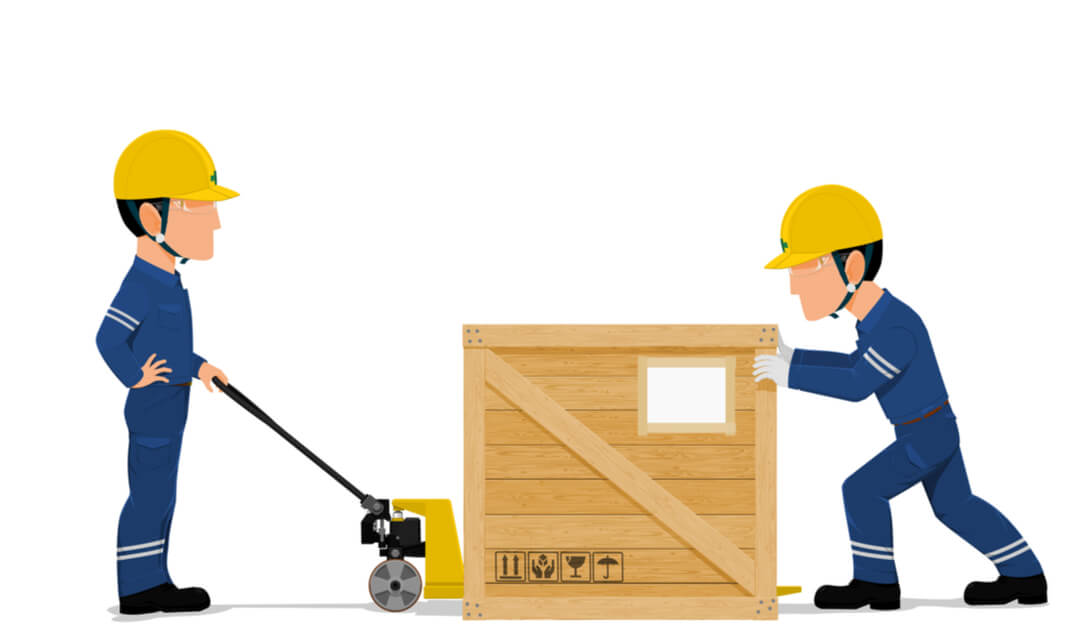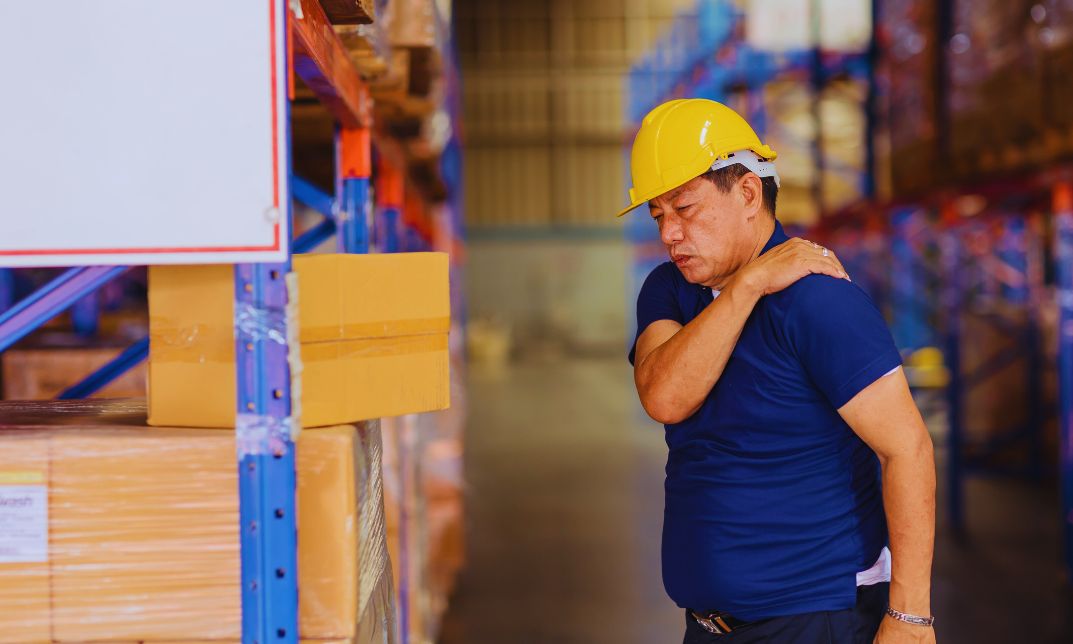No products in the basket.
Lifting or carrying things might seem simple. But it can quickly cause injuries if you’re not careful. That’s why knowing what TILE stands for is so important. Basically, it’s a quick check. You look at the task, yourself as the Individual, the Load and the Environment before moving anything. If anything feels unsafe, just stop and figure out a safer way. By doing this, you can catch problems early and make lifting much safer, easier, and smarter every time.
Let’s look closer at TILE and see how it helps you lift safely every time.
Understanding What TILE Stands For
Now that you know why safe lifting matters, let’s break down each part of TILE so you can use it easily at work.
- T — Task: What exactly are you doing? Take a moment to plan your move.
- I — Individual: Are you ready? Check your feelings, energy and whether you need a hand.
- L — Load: What are you moving? Ensure it’s not too heavy, wobbly or awkward to hold.
- E — Environment: Where are you moving it? Look out for obstacles, wet floors or tight spaces.
To make it easier to remember, just think: Track the job, I check myself, Look at the load, Eye the route.
Different Versions of TILE
Manual handling uses a few simple acronyms to help you remember safety steps. You’ve probably heard of TILE, but sometimes people use LITE or TILEO instead. Don’t worry, they all mean almost the same thing. Let’s quickly see how they’re different.
What Is LITE?
LITE is really just TILE in a different order. It stands for Load, Individual, Task, and Environment. The point is the same: think about the weight, the person lifting, what needs doing, and where it’s happening. In fact, the difference is mostly in the order, and some workplaces like LITE because it’s easier to remember.
What Is TILEO?
You might also hear people talk about TILEO instead of TILE. Basically, it means almost the same thing. The only difference is the letter O, which stands for Other factors.
Now, what does that mean? It’s about looking at anything that could affect your safety while lifting or moving something. For example, is your safety gear too tight to move freely? Do you need better gloves or shoes? Is the floor wet or uneven?
So, when you think of TILEO, remember it’s just an extra reminder to notice the little things that can make a big difference in keeping you safe.
Why Is TILE Important in Manual Handling?
TILE takes only a few seconds but can make lifting, carrying, pushing, or pulling much safer. It helps you spot risks before they become injuries and shows you easier, smarter ways to move things. Here’s why TILE really matters:
- Protects your body: Cuts down the chance of back pain, muscle strains, or other injuries.
- Prevents accidents: Makes sure your path is clear and avoids slips, trips or falls.
- Guides safer moves: Let’s quickly decide if you need a trolley, a team lift or a shorter route.
- Saves time and downtime: A 10-second check can prevent weeks of recovery later.
T—Task: What Should You Assess First?
The first thing to think about is the task itself. Ask yourself how to make it safer and easier before moving anything. Always check these points before you lift:
- Avoid/Reduce: Can you divide the load, shorten the carry, or use equipment (trolley, sack truck, pallet truck, lift)?
- Route plan: Doors? Corners? Slopes? Stairs? Plan set-down points.
- Body moves: Can you do it without twisting or reaching above shoulder height?
Quick tool: If it can be pushed safely, pushing usually beats pulling.
I—Individual: Are You Personally Safe to Lift?
Before lifting anything, it’s important to check yourself and ensure you’re ready. Here’s what to think about:
- Fit today?: Are you feeling okay? Any pain, tiredness, illness, or tight clothing/shoes that might make lifting risky?
- Competent?: Do you know how to do this safely? Are you trained for the task or using the equipment? Do you need gloves or other safety gear?
- Backup?: Would it be safer or quicker if a second person helped you?
Stop/Go rule: If you’d hesitate to do this lift five times, pause and get help or use equipment.
L — Load: What About the Object Itself?
Before you even touch the load, seeing what you’re dealing with is worth it. Check these things first:
- Weight/shape: Is it bulky, wobbly or likely to shift around (like liquids or loose parts)?
- Grip: Can you hold it safely? Look for handholds, straps, edges or clues from the packaging.
- Test: Gently nudge it with your hand or foot to gauge its weight—don’t commit if it feels too heavy or moves unexpectedly.
Simple fix: If needed, repack it to make it lighter or smaller or add handles to make it easier to lift.
E — Environment: Is the Area Safe and Clear?
Before you move anything, it’s important to ensure the area is safe and clear. Take a quick look at these points first:
- Ground: Is it dry and even? Clear away cables or clutter, and fix any wet patches.
- Space: Do you have enough room to turn and set the load down safely?
- Lighting/visibility: Are the lights on? Check blind corners and watch out for ramps or stairs.
Team cue: If someone is helping you, agree on who opens doors and where the load will be set down.
How Do You Apply the TILE Method Step by Step?
Using TILE is quick and practical; you can choose how much time to spend depending on the situation. Here’s how it works:
10-Second TILE:
- Look → Decide → Act: Look at the Task, Individual, Load, and Environment. Then decide if you can do it alone, need equipment, or a team.
60-Second TILE: Take a little extra time to plan safely:
- Plan route & set-downs: Check your path and where the load will go.
- Check yourself & PPE: Make sure you’re ready and have any protective gear you need.
- Inspect & test load: Make sure lifting or moving is safe.
- Clear the environment: Remove obstacles and hazards along the way.
- Lift properly: Feet hip-width apart, load close, bend knees, keep a neutral spine, and turn your feet instead of twisting.
- Set down safely: Place the load carefully and securely.
- Review & adjust: Think about what went well and what could be improved next time.
By following these steps, you make lifting safer, easier, and less risky every time.
Legal Requirements & Responsibilities
In the UK, the Manual Handling Operations Regulations 1992 make it a legal duty for employers to protect workers from injuries caused by lifting, carrying, pushing, or pulling. Employers must first try to avoid manual handling wherever possible. If it can’t be avoided, they must assess the task and take steps to reduce any risks, such as providing safe systems of work, proper training, or suitable equipment. Employees also have responsibilities — they should follow safe lifting advice, use any equipment provided, and report hazards or injuries straight away.
Following the TILE steps helps everyone meet these legal requirements by making it easy to check risks, plan safely, and prevent injuries before they happen.
Who Needs TILE Training?
TILE training isn’t just for people who lift heavy stuff every day. In fact, it’s for anyone who lifts, carries, pushes, or pulls at work. This includes people in care homes, hospitals, schools (like teaching assistants and teachers), facilities teams, retail, warehouses, and hospitality. Even light loads can cause strains or slips if you’re not careful.
A quick refresher is really useful for new starters or anyone changing roles. It helps them understand safe ways to handle things in their new job. Also, don’t forget to report near-misses. Your team can spot risks early and fix them before anyone gets hurt.
By following TILE, staff can work smarter, reduce injuries, and feel more confident moving loads daily.
FAQs
- What does the TILE acronym stand for?
TILE stands for Task, Individual, Load, Environment—the four key things to check before lifting or moving anything.
- What is the TILE method of risk assessment?
It’s a quick, practical way to check risks before lifting, carrying, pushing, or pulling, helping prevent injuries.
- What is a TILE in healthcare?
TILE is a safety check staff use before handling patients or equipment to reduce the risk of injury in healthcare.
- What are the four components of TILE risk assessment?
The four components are Task, Individual, Load, and Environment, each helping you plan the lift safely.
- What are the 3 C’s of risk assessment?
The 3 C’s are Consider, Check, and Control, a simple way to evaluate and manage risks.
- What are the 4 P’s in risk assessment?
The 4 Ps are people, place, process, and purpose, which help cover all safety aspects.
- What PPE is needed for TILE handling?
Basic PPE usually includes gloves, suitable footwear, and any other gear needed for your task.
Final Thoughts: Make TILE a Habit
Once you understand what TILE stands for and how to use it practically, it quickly becomes second nature. So, always think TILE before every move—small checks, big safety wins. This simple habit helps you lift, carry, push, or pull safely and avoid injuries. Also, for extra convenience, print a pocket card and keep it with you so you can quickly check the steps whenever you need.
Want more confidence in every lift? Sign up for the Manual Handling Course at the Training Tale now!




